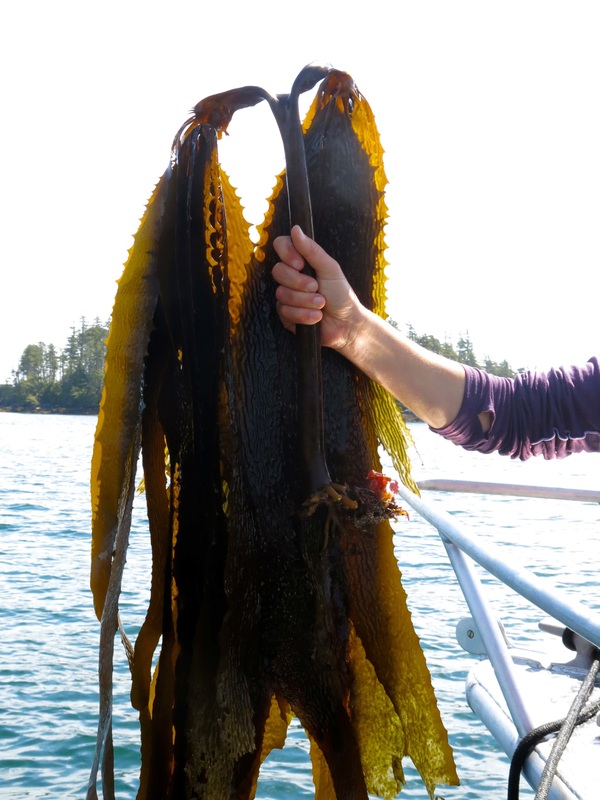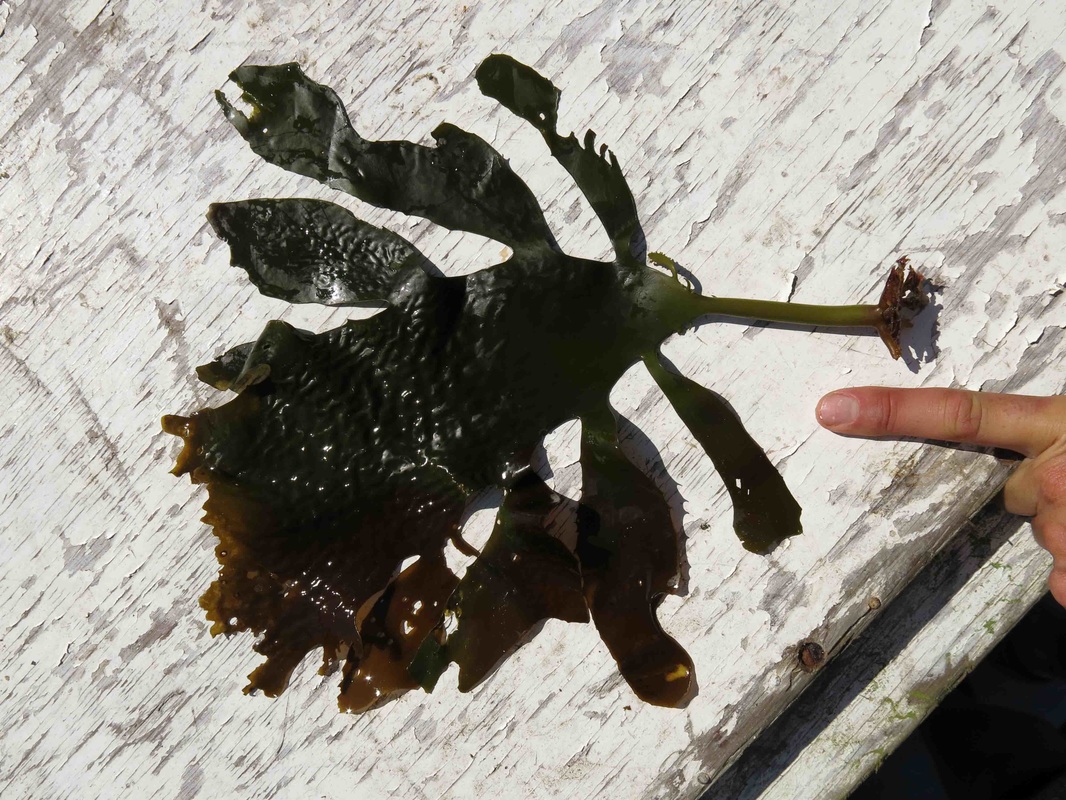Palm kelp, double pompom kelp • Ecklonia arborea, formerly Eisenia arborea
{arborea = tree-like}
Identification
This brown alga has a palm-like appearance, with two bunches of blades originating from a thick, stiff stipe to 1.5 m long. The end of the stipe is forked, resulting in an obvious division between the two blade bunches. These blades reach 40 cm long, have strongly toothed margins, and tend to have a rippled texture - though palm kelp growing in more exposed locations may have smoother blades. Juveniles appear very different from fully grown individuals.
Habitat & Range
Palm kelp grows in the most exposed areas of the intertidal and subtidal to 3 m deep. Its range is not continuous: it is found in British Columbia and from Monterey, California to northern Mexico. The reason for its absence in Washington and Oregon is unknown. It is cultivated in Japan and Peru.
Similar Species
Sea palm (Postelsia palmaeformis) has a smaller stipe (to 60 cm tall), which splits into numerous branches from which the blades arise. Central BC is at the northern extent of its range.
Human Uses
Palm kelp is used for a variety of different purposes: in Asian cuisine under the name Arame, as aquaculture feed, as a folk remedy against allergies, and as a moisturizer in cosmetics and soaps.
This brown alga has a palm-like appearance, with two bunches of blades originating from a thick, stiff stipe to 1.5 m long. The end of the stipe is forked, resulting in an obvious division between the two blade bunches. These blades reach 40 cm long, have strongly toothed margins, and tend to have a rippled texture - though palm kelp growing in more exposed locations may have smoother blades. Juveniles appear very different from fully grown individuals.
Habitat & Range
Palm kelp grows in the most exposed areas of the intertidal and subtidal to 3 m deep. Its range is not continuous: it is found in British Columbia and from Monterey, California to northern Mexico. The reason for its absence in Washington and Oregon is unknown. It is cultivated in Japan and Peru.
Similar Species
Sea palm (Postelsia palmaeformis) has a smaller stipe (to 60 cm tall), which splits into numerous branches from which the blades arise. Central BC is at the northern extent of its range.
Human Uses
Palm kelp is used for a variety of different purposes: in Asian cuisine under the name Arame, as aquaculture feed, as a folk remedy against allergies, and as a moisturizer in cosmetics and soaps.
References
Eisenia arborea. Seaweed Industry Association. Accessed 17/06/2015.
Guiry, M.D. & Guiry, G.M. (2015). Eisenia arborea Areschoug. AlgaeBase. National University of Ireland, Galway. Accessed 17/06/2015.
Lamb, A., and Hanby, B. (2005). Marine Life of the Pacific Northwest [electronic version]. Madeira Park, BC: Harbour Publishing.
O'Clair, R. and Lindsrom, S. Postelsia palmaeformis Ruprecht. In Klinkenberg, Brian. (Ed.). E-Flora BC: Electronic Atlas of the Plants of British Columbia. Lab for Advanced Spatial Analysis, Department of Geography, University of British Columbia, Vancouver. Accessed 17/06/2015.
Authors and editors of page
Kelly Fretwell and Brian Starzomski (2015).
Eisenia arborea. Seaweed Industry Association. Accessed 17/06/2015.
Guiry, M.D. & Guiry, G.M. (2015). Eisenia arborea Areschoug. AlgaeBase. National University of Ireland, Galway. Accessed 17/06/2015.
Lamb, A., and Hanby, B. (2005). Marine Life of the Pacific Northwest [electronic version]. Madeira Park, BC: Harbour Publishing.
O'Clair, R. and Lindsrom, S. Postelsia palmaeformis Ruprecht. In Klinkenberg, Brian. (Ed.). E-Flora BC: Electronic Atlas of the Plants of British Columbia. Lab for Advanced Spatial Analysis, Department of Geography, University of British Columbia, Vancouver. Accessed 17/06/2015.
Authors and editors of page
Kelly Fretwell and Brian Starzomski (2015).





